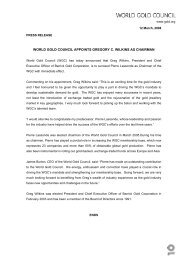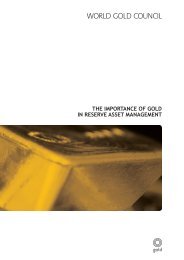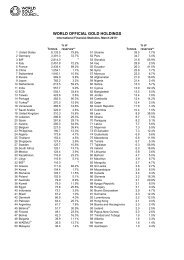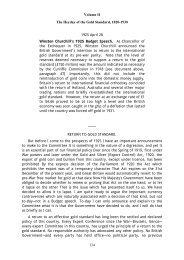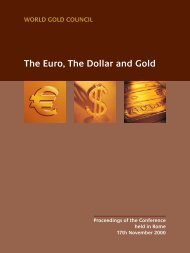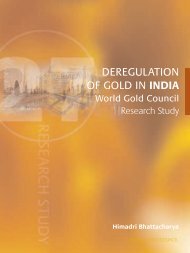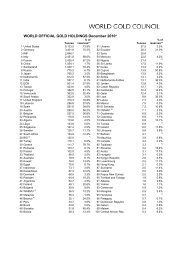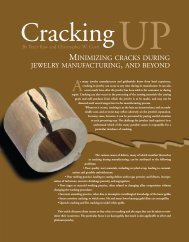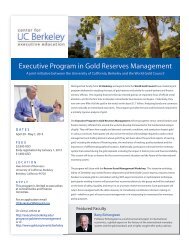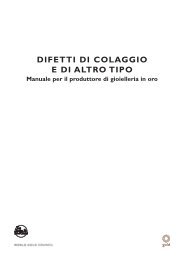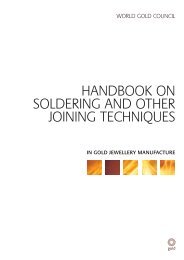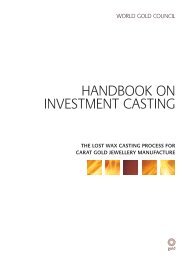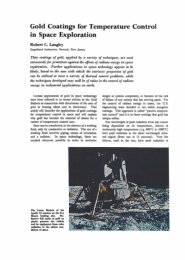Gold Derivatives: Gold Derivatives: - World Gold Council
Gold Derivatives: Gold Derivatives: - World Gold Council
Gold Derivatives: Gold Derivatives: - World Gold Council
Create successful ePaper yourself
Turn your PDF publications into a flip-book with our unique Google optimized e-Paper software.
producer faces price risk because of the time which elapses between making the<br />
production decision and selling the commodity. When the producer decides to<br />
invest in new capacity he incurs known costs, but the revenues are uncertain<br />
because the price he will eventually receive for his output is unknown. In deciding<br />
how much to produce (‘the investment decision’), the producer has to depend<br />
on his own forecast of the future spot price of the commodity and bear the<br />
risk of his forecast being wrong.<br />
Suppose now that a forward market is opened. The producer has two decisions<br />
to take: an investment decision (how much, and indeed whether, to produce),<br />
and a hedging decision (what proportion of the output to be sold forward rather<br />
than spot). Provided certain conditions are met (the producer is too small to<br />
affect prices, the producer is seeking to maximise the utility of terminal wealth,<br />
and the only significant source of uncertainty is the future spot price), then in<br />
the presence of a forward market the investment and hedging decisions are<br />
separable. The investment decision should be taken purely on the basis of the<br />
forward price at the time the investment decision is taken. The producer should<br />
act as if all the output will be sold on the forward market. The forward price of<br />
the commodity should determine the production level whether or not the producer<br />
decides to sell his output forward, and whether or not he believes the<br />
forward price is reasonable.<br />
That is not to say that the producer should sell all his output forward. If for<br />
example the forward price is far below the producer’s expectation of the future<br />
spot price, and if he believes in his own forecast, he should not sell all his output<br />
forward. Rather he should sell some or all of his output on the spot market.<br />
To put the point another way: in the absence of a forward market, the producer<br />
necessarily acts on the basis of his own forecast of future spot prices and takes<br />
investment decisions which take account of the uncertainty of the price at which<br />
he will actually sell. With a forward market, investment decisions can be taken on<br />
the basis of the current forward price, and uncertainty about the future price is no<br />
longer a factor in investment decisions.<br />
A number of important consequences flow from this separability result. In a world<br />
where producers do not know much about the forecasts and production plans of<br />
other producers, the forward price captures valuable information which makes<br />
the investment process more efficient. The forward market makes it difficult for<br />
the infamous ‘hog cycle’, beloved of economics text books, to materialise. In the<br />
hog cycle, underproduction one year leads to a shortage with consequent high<br />
prices. This attracts new producers into the market, leading to a glut the following<br />
year. The result is a very volatile price. In the presence of a forward market in<br />
hogs, this type of behaviour would not occur. With a forward market, the feedback<br />
loop is instantaneous and production plans which in aggregate will lead to<br />
<strong>Gold</strong> <strong>Derivatives</strong>: The market impact 89



